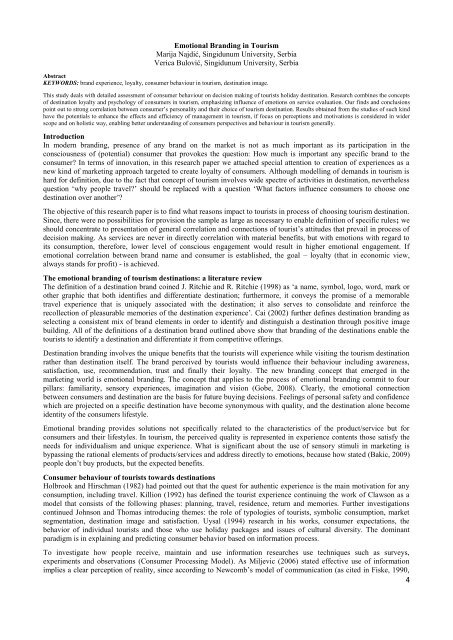Brand, Identity and Reputation: Exploring, Creating New Realities ...
Brand, Identity and Reputation: Exploring, Creating New Realities ...
Brand, Identity and Reputation: Exploring, Creating New Realities ...
You also want an ePaper? Increase the reach of your titles
YUMPU automatically turns print PDFs into web optimized ePapers that Google loves.
Emotional <strong>Br<strong>and</strong></strong>ing in Tourism<br />
Marija Najdić, Singidunum University, Serbia<br />
Verica Bulović, Singidunum University, Serbia<br />
Abstract<br />
KEYWORDS: br<strong>and</strong> experience, loyalty, consumer behaviour in tourism, destination image.<br />
This study deals with detailed assessment of consumer behaviour on decision making of tourists holiday destination. Research combines the concepts<br />
of destination loyalty <strong>and</strong> psychology of consumers in tourism, emphasizing influence of emotions on service evaluation. Our finds <strong>and</strong> conclusions<br />
point out to strong correlation between consumer‘s personality <strong>and</strong> their choice of tourism destination. Results obtained from the studies of such kind<br />
have the potentials to enhance the effects <strong>and</strong> efficiency of management in tourism, if focus on perceptions <strong>and</strong> motivations is considered in wider<br />
scope <strong>and</strong> on holistic way, enabling better underst<strong>and</strong>ing of consumers perspectives <strong>and</strong> behaviour in tourism generally.<br />
Introduction<br />
In modern br<strong>and</strong>ing, presence of any br<strong>and</strong> on the market is not as much important as its participation in the<br />
consciousness of (potential) consumer that provokes the question: How much is important any specific br<strong>and</strong> to the<br />
consumer? In terms of innovation, in this research paper we attached special attention to creation of experiences as a<br />
new kind of marketing approach targeted to create loyalty of consumers. Although modelling of dem<strong>and</strong>s in tourism is<br />
hard for definition, due to the fact that concept of tourism involves wide spectre of activities in destination, nevertheless<br />
question ‗why people travel?‘ should be replaced with a question ‗What factors influence consumers to choose one<br />
destination over another‘?<br />
The objective of this research paper is to find what reasons impact to tourists in process of choosing tourism destination.<br />
Since, there were no possibilities for provision the sample as large as necessary to enable definition of specific rules; we<br />
should concentrate to presentation of general correlation <strong>and</strong> connections of tourist‘s attitudes that prevail in process of<br />
decision making. As services are never in directly correlation with material benefits, but with emotions with regard to<br />
its consumption, therefore, lower level of conscious engagement would result in higher emotional engagement. If<br />
emotional correlation between br<strong>and</strong> name <strong>and</strong> consumer is established, the goal – loyalty (that in economic view,<br />
always st<strong>and</strong>s for profit) - is achieved.<br />
The emotional br<strong>and</strong>ing of tourism destinations: a literature review<br />
The definition of a destination br<strong>and</strong> coined J. Ritchie <strong>and</strong> R. Ritchie (1998) as ‗a name, symbol, logo, word, mark or<br />
other graphic that both identifies <strong>and</strong> differentiate destination; furthermore, it conveys the promise of a memorable<br />
travel experience that is uniquely associated with the destination; it also serves to consolidate <strong>and</strong> reinforce the<br />
recollection of pleasurable memories of the destination experience‘. Cai (2002) further defines destination br<strong>and</strong>ing as<br />
selecting a consistent mix of br<strong>and</strong> elements in order to identify <strong>and</strong> distinguish a destination through positive image<br />
building. All of the definitions of a destination br<strong>and</strong> outlined above show that br<strong>and</strong>ing of the destinations enable the<br />
tourists to identify a destination <strong>and</strong> differentiate it from competitive offerings.<br />
Destination br<strong>and</strong>ing involves the unique benefits that the tourists will experience while visiting the tourism destination<br />
rather than destination itself. The br<strong>and</strong> perceived by tourists would influence their behaviour including awareness,<br />
satisfaction, use, recommendation, trust <strong>and</strong> finally their loyalty. The new br<strong>and</strong>ing concept that emerged in the<br />
marketing world is emotional br<strong>and</strong>ing. The concept that applies to the process of emotional br<strong>and</strong>ing commit to four<br />
pillars: familiarity, sensory experiences, imagination <strong>and</strong> vision (Gobe, 2008). Clearly, the emotional connection<br />
between consumers <strong>and</strong> destination are the basis for future buying decisions. Feelings of personal safety <strong>and</strong> confidence<br />
which are projected on a specific destination have become synonymous with quality, <strong>and</strong> the destination alone become<br />
identity of the consumers lifestyle.<br />
Emotional br<strong>and</strong>ing provides solutions not specifically related to the characteristics of the product/service but for<br />
consumers <strong>and</strong> their lifestyles. In tourism, the perceived quality is represented in experience contents those satisfy the<br />
needs for individualism <strong>and</strong> unique experience. What is significant about the use of sensory stimuli in marketing is<br />
bypassing the rational elements of products/services <strong>and</strong> address directly to emotions, because how stated (Bakic, 2009)<br />
people don‘t buy products, but the expected benefits.<br />
Consumer behaviour of tourists towards destinations<br />
Holbrook <strong>and</strong> Hirschman (1982) had pointed out that the quest for authentic experience is the main motivation for any<br />
consumption, including travel. Killion (1992) has defined the tourist experience continuing the work of Clawson as a<br />
model that consists of the following phases: planning, travel, residence, return <strong>and</strong> memories. Further investigations<br />
continued Johnson <strong>and</strong> Thomas introducing themes: the role of typologies of tourists, symbolic consumption, market<br />
segmentation, destination image <strong>and</strong> satisfaction. Uysal (1994) research in his works, consumer expectations, the<br />
behavior of individual tourists <strong>and</strong> those who use holiday packages <strong>and</strong> issues of cultural diversity. The dominant<br />
paradigm is in explaining <strong>and</strong> predicting consumer behavior based on information process.<br />
To investigate how people receive, maintain <strong>and</strong> use information researches use techniques such as surveys,<br />
experiments <strong>and</strong> observations (Consumer Processing Model). As Miljevic (2006) stated effective use of information<br />
implies a clear perception of reality, since according to <strong>New</strong>comb‘s model of communication (as cited in Fiske, 1990,<br />
4
















